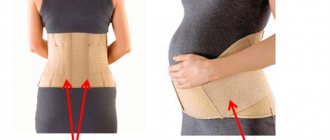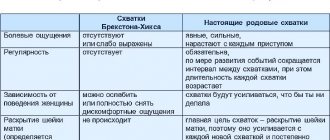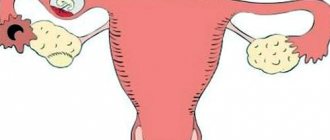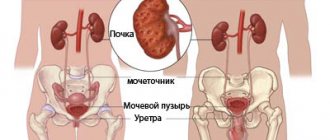How does childbirth happen at 38 weeks of pregnancy?
The process of delivery at 38 weeks proceeds as expected.
It consists of three main stages:
- First, the woman goes into labor. During this time, the cervix becomes thinner and stretches.
- Then it is necessary to make attempts so that the child begins to move through the birth canal and is born.
- The final stage is the release of the placenta or the so-called placenta. This is where the birth ends.
What's happening to the stomach?
The size of the abdomen increases greatly at this time, and it can be difficult for a woman to even move with such a load. Problems also arise when choosing the most comfortable body position during a night's rest. The skin on the abdomen is very tight, dry and may itch.
The navel becomes flattened and sometimes even turns outward. There is no need to worry about such an unaesthetic appearance of the navel; after childbirth everything will return to normal.
At 38 weeks, many women notice that their belly has dropped down. This is a variant of the norm. The baby is simply preparing to be born, and his head is pressed closer to the pelvic floor.
Features of fetal development
At this time, the child turns out to be completely ready for life outside the mother’s belly. All organ systems function fully. If a woman continues to bear the fetus, then no significant changes in its development will occur. The baby will simply continue to grow in length and gain weight. At this time, the baby weighs 3 kg or more, and his height is on average 50 cm. Every day his body weight increases by another 30 g.
The baby's skin became pink and smooth. Lanugo and vernix have almost completely disappeared.
The baby's first stool (meconium), which is dead skin cells, has formed in the baby's intestines. As a rule, it comes out after the baby is born. However, there are situations when the baby has bowel movements while still in the womb. In this case, the amniotic fluid becomes greenish in color, and the baby itself will be covered in green mucus at birth.
If a woman is carrying a male child, by this time his testicles have already descended into the scrotum. This is a very important point, so after the baby is born, the doctor will definitely check this fact.
Feelings at 38 weeks of pregnancy
At this time, the woman notices that the child has begun to move less compared to previous weeks. The fact is that there is very little space in the uterus, so the baby can no longer afford too intense pushes. In addition, cephalic presentation of the fetus affects it.
At 38 weeks, the baby can only turn and make slight movements. But the woman will definitely feel these movements. Moreover, they need to be carefully monitored. The number of movements in one day should be at least 10. If they are absent for a long time or their number has decreased significantly, then you need to consult a doctor as soon as possible. Often this indicates problems in the child and even a possible threat to his life, which can be quickly eliminated if timely surgical intervention is performed.
At 38 weeks of pregnancy, most women are already expecting an imminent birth. Some of them feel tired, some are burdened by obesity and restrictions in movement. Therefore, many pregnant women eagerly await the onset of contractions.
Lowering the abdomen helps ease breathing, improves digestion, and eliminates belching and heartburn. After all, the uterus no longer puts so much pressure on the diaphragm and stomach.
Causes of pain at 38 weeks of pregnancy
Unpleasant and even painful sensations that occur at the end of pregnancy are a completely natural phenomenon.
- Low back pain is the result of ligaments and joints relaxing. This process helps prepare the birth canal for the upcoming event. In addition, the center of gravity shifts due to the increased body weight of the child. Therefore, lower back pain can be quite intense.
- The pelvic bones also experience increased stress, because at this time the child is already tightly pressed to the pelvic floor. This provokes the appearance of pain in the area of the pubic symphysis.
- Pain localized in the sacral area is caused by compression of the femoral nerve, which is located next to the uterus.
- Painful sensations in the calves can occur due to a lack of calcium in a woman’s body.
- Sometimes the pain occurs like contractions, but these contractions may not be real, but false (not to be confused with Braxton-Higgs contractions, which are painless). False contractions will be characterized by pain and increased frequency. In order to eliminate them, you need to walk around the apartment or change your body position. If the contractions are truly false, they will stop.
Also, at 38 weeks of pregnancy, a woman may experience slight swelling, which is normal. At the same time, the woman’s well-being should not worsen. If the swelling is severe, and there are also symptoms of illness such as headaches, double vision, diarrhea, then you should call an ambulance. As a rule, such signs indicate preeclampsia - this is gestosis, accompanied by impaired cerebral circulation.
Warning signs
Signs that require calling a doctor
Signs that should alert you:
- high blood pressure;
- bleeding;
- headache;
- sensation of a foreign body in the vagina.
The following symptoms may indicate the presence of serious pathologies requiring medical intervention:
- Placental abruption. It is characterized by damage to the vascular tissues connecting the baby's place and the uterus. Requires hospitalization and can only be diagnosed by ultrasound.
- Placenta previa. Makes it impossible to give birth naturally, as the entrance to the uterus is closed. The opening process provokes ruptures and bleeding. It is typical for women who have undergone termination of pregnancy or surgery on the uterus.
- Preeclampsia. Causes headaches and increased blood pressure, accompanied by pain in the epigastric region. A woman in labor may complain about blurry outlines of objects. Obstetrics are indicated; if symptoms appear, you should seek medical help.
- Umbilical cord prolapse. If you feel a foreign body between your legs, you should urgently call an ambulance. The umbilical cord may fall out during the uterine effacement stage, when contractions have not yet become more frequent. Before the doctors arrive, great care must be taken, since the umbilical cord should not be pinched.
Which discharges are considered normal and which are pathological?
Discharge is always present at 38 weeks of pregnancy. Normally, they have a milky color, a uniform consistency, and may have a slight sour odor.
Don't panic if there is mucus in the discharge. The fact is that at such late stages of pregnancy the uterus becomes soft and can open slightly. This explains the presence of mucus in the discharge.
The imminent onset of labor is indicated by the release of the mucous plug. In this case, the discharge becomes stretchy and thick, with streaks of blood present. Sometimes the mucus has a pink tint.
Most often, the plug comes out at 38 weeks of pregnancy, although this can happen a week earlier or a week later.
A deviation from the norm is the appearance of cheesy discharge. You should immediately consult a doctor if there is pus or flakes in the discharge, or if there is an unpleasant odor. Such discharge indicates the addition of an infection, which requires proper treatment.
Bloody discharge at 38 weeks requires an immediate call to an ambulance. Blood most often indicates placental abruption. Blood can also appear as a result of placenta previa. However, if the woman was observed by a doctor, then presentation should be excluded. Placental abruption is a serious complication that threatens the life of the fetus. You should not ignore even minor bloody discharge, because severe bleeding can begin at any moment.
Cloudy discharge with a liquid consistency indicates the release of water. This is a clear signal that you need to go to the maternity hospital. The waters break before the approaching birth, or due to the thinning of the placental wall. In any case, the woman needs medical assistance.
Vaginal discharge
Heavy discharge should alert you.
During the period of waiting for the baby, you need to monitor mucous discharge. Changes in their character indicate the imminent approach of childbirth or the presence of pathological conditions. Discharges are:
- Evidence of normal pregnancy. White or light yellow discharge that is odorless indicates the health of the mother and fetus.
- Slimy in nature. Often they signal the beginning of the labor process, since the appearance of discharge indicates the removal of the plug. It may come out completely or come out in parts, then the mucus will come out for several days.
- Watery type. They signal the beginning of the discharge of amniotic fluid. They may go away completely or leak out gradually. If a woman in labor notices an increase in the total volume of discharge and notes its watery nature, then the second option occurs. In this case, you must urgently consult a doctor, as leakage poses a danger to the fetus.
- With a reddish or pinkish tint. If such discharge is not associated with the removal of the plug, then their presence should alert you. The presence of blood impurities may be due to the passage of the placenta or other pathologies.
- Green and yellow. Indicate infection and the occurrence of an inflammatory process. They are usually accompanied by nagging pain, itching and an unpleasant odor.
Sometimes the discharge may change after a medical examination. However, after a few hours they should return to normal. If this does not happen, then you should definitely consult a doctor. During the examination, the plug could be damaged, which would trigger the onset of labor.
Sex
Having sex at 38 weeks of pregnancy is a rather controversial point. Of course, intimate life will bring pleasure to a woman, and the level of the joy hormone in the body will increase. Sex also increases blood circulation in the pelvis, which means the placenta will be enriched with oxygen.
However, at this late stage the uterus becomes very sensitive, and the birth canal opens slightly. Therefore, during sex, you can damage the cervix and cause minor bleeding.
Having sex at 38 weeks of pregnancy can result in the onset of labor. This is a natural way to induce labor, but you can resort to it only after consulting a doctor.
Diagnostics
The last examination using an ultrasound machine occurs at week 38. It allows you to assess the position of the fetus, find out its size and weight. The specialist listens to the child’s heartbeat to identify possible pathologies. During an examination with a gynecologist, pressure and height of the uterine fundus are measured. The doctor assesses the woman’s readiness for birth and examines the birth canal.
The woman in labor donates blood and urine for tests almost every week. This measure allows you to assess the presence of pathologies. Anemia will be indicated by a drop in red blood cells, and a low level of blood clotting will indicate a decrease in platelet contraction.
Important! An increase in white blood cells will indicate inflammation, and an increase in sugar will indicate a pre-diabetic state.
What dangers can await a woman at 38 weeks of pregnancy?
Preeclampsia is one of the most dangerous conditions that requires immediate emergency medical attention. Preeclampsia is indicated by severe swelling, dizziness, surges in blood pressure, and diarrhea.
If a woman experiences severe pain in the lower abdomen, which resembles electric shocks, then she should go to the maternity hospital. As a rule, such sensations are a sure sign of the onset of labor. They arise for the reason that the child has begun to move along the birth canal, and in doing so he touches the nerve endings.
Causes of abdominal pain during pregnancy
18.10.2021
On the one hand, abdominal during pregnancy can be a warning symptom and require urgent diagnostic studies, and on the other hand, it can be a natural sign of changes occurring in a woman’s body during pregnancy , or a harbinger of childbirth . Abdominal pain is one of the symptoms most commonly reported by pregnant women. When analyzing this disease, special attention should be paid to the characteristics of abdominal during pregnancy , such as its location, nature, intensity, accompanying symptoms and factors that aggravate or alleviate symptoms.
Abdominal pain during pregnancy
Abdominal pain during pregnancy is primarily a warning symptom that causes reflex, autonomic, motor and emotional reactions. Subjectively and individually, it feels like any other pain. Abdominal pain in pregnant women is often caused by constipation
Abdominal pain during pregnancy can have different causes. Frequent causes, especially of chronic ailments, are movement disorders and functional diseases of the gastrointestinal tract, which are often found in pregnant women. Many expectant mothers struggle with constipation. They appear from the very beginning of pregnancy and often last until its completion. Constipation is a result of the lengthening of the gastrointestinal tract under the influence of progesterone and relaxation of the pelvic floor muscles.
stomach pain caused by constipation ? Gynecologists recommend following a diet rich in natural fibers and consuming plenty of fluids, especially still mineral water. It is necessary to exclude indigestible, fatty, highly spicy foods from the menu and limit the consumption of white bread, potatoes or pasta. It is worth supplementing with pharmacological preparations of plant origin, the purpose of which is to stimulate intestinal and soften food residues.
What does abdominal pain on the right side mean during pregnancy?
Pain located in the upper quadrant of the abdomen , in the area of the right hypochondrium, may be a sign of biliary tract diseases. A condition characterized by abdominal on the right side is intrahepatic cholestasis of pregnancy (ICP).
The causes of intrahepatic cholestasis are not fully understood. However, its immediate cause is an increase in estrogen and progesterone levels in pregnant women; it is usually observed in the third trimester. Moreover, it is more often diagnosed in multiple pregnancies . Intrahepatic cholestasis of pregnancy is a serious complication. It should be treated as soon as the fetus is ripe to prevent intrauterine death.
Pain in the right side of the abdomen may be a symptom of appendicitis
Pain in the right side of the abdomen during pregnancy , which after a few hours is especially localized in the lower quadrants of the abdomen , near the right iliac fossa, may indicate appendicitis . The pain is constant and is accompanied by symptoms such as lack of appetite, nausea , vomiting, gas and stool retention, increased body temperature and abdominal .
This disease is considered the most common non-obstetric indication for emergency surgery in pregnant women. It is estimated to account for 25% of such surgical procedures. It is possible to perform a laparoscopic appendectomy. Antibacterial therapy and even termination of pregnancy by cesarean section . The incidence of appendicitis during pregnancy ranges from 1:500 to 1:2000 and does not vary depending on the stage. Research shows that the position of the appendix changes in the expectant mother.
Pain in the lower abdomen during pregnancy - inflammation of the bladder
Pain in the lower abdomen during pregnancy , in the suprapubic region, can occur with diseases of the genitourinary system such as cystitis . Pregnancy usually delays diagnosis because symptoms such as pollakiuria, urgency, abdominal and lower abdominal are also observed in normal pregnancy . Antimicrobial treatment lasts 3–7 days. The same medications are recommended as for asymptomatic bacteriuria.
Pain in the lower abdomen during pregnancy in the 2nd and 3rd trimesters - acute pyelonephritis
Pain in the lower abdomen during pregnancy in the 2nd and 3rd trimesters may indicate acute pyelonephritis . According to statistics, this condition is more common in pregnant women. It affects an estimated 2% of expectant mothers. The therapy is not much different from the treatment of non-pregnant women. It usually takes 7-10 days. Acute pyelonephritis develops at the turn of the 2nd–3rd trimester of pregnancy . It is facilitated by obstructed urine and changes in the urinary tract in pregnant women. Characteristic symptoms of the disease are: pain in the lower abdomen , fever, pain in the lumbar region, chills, nausea , headache and vomiting.
Causes of abdominal pain during pregnancy on the left
Pain located on the left side of the abdomen in the lower quadrant may indicate an ectopic pregnancy . In recent years, the incidence has tended to increase - 1.5–2%. Every case of ectopic pregnancy is a life-threatening condition for the pregnant woman. Its symptoms are severe abdominal , bleeding from the genital tract, swelling in the adnexal region, abdominal tenderness and fluid in the pouch of Douglas.
Published in Pregnancy and pregnancy management Premium Clinic











